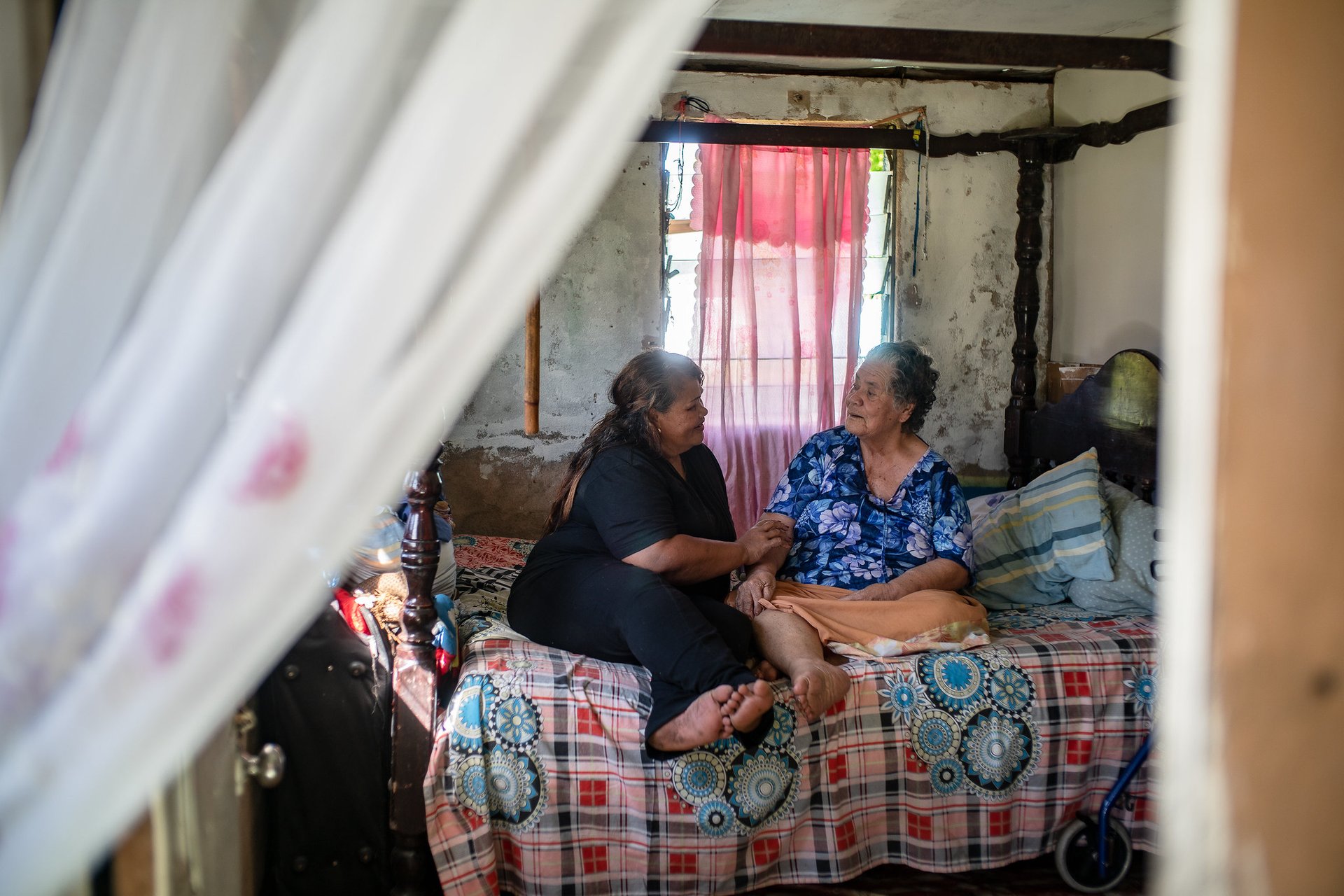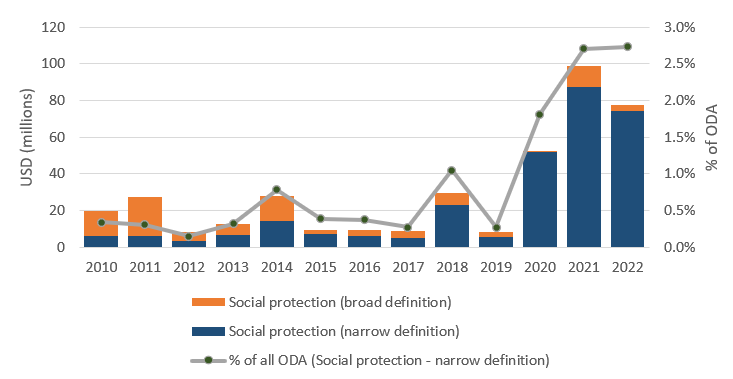FINANCING SOCIAL PROTECTION IN THE PACIFIC AND TIMOR-LESTE
Financing social protection in the Pacific and Timor-Leste
By Jesse Doyle and Charles Knox-Vydmanov
Amelia Akauola with her caregiver, Linda Vi, in Tonga. Photo by ADB.
Governments in the Pacific and Timor-Leste have been investing in formal social protection for more than 50 years, but the last two decades have seen massive shifts.
Across the region, expenditure on social assistance programs has almost doubled, and benefits expanded gradually to reach many more people. While some countries are leading the way, and others lag behind, the broader trends point to lessons and considerations for future growth and investment in social protection.
A recent study by the Australian-Government program Partnerships for Social Protection (P4SP) delved into the trends around social protection investments in the region.
Investing in social protection for good times and bad: An assessment of social protection financing in the Pacific and Timor-Leste unpacks who is financing social protection in the Pacific, how investments have evolved, the impact of inflation, and the fiscal outlook for these countries coming out of the COVID-19 pandemic. It brings in the latest data, building on a previous P4SP report that looked at social protection expenditure across 10 countries in the region.
Old age and disability benefits are a standout feature of social protection systems in the Pacific and Timor-Leste. While these schemes exist in many low- and middle-income countries globally, eight of the 14 Pacific countries studied have both schemes, typically provided universally. In addition, countries such as Marshall Islands, Papua New Guinea, Timor-Leste and Tonga have been experimenting with new kinds of cash benefits for families with children, providing coverage for a group that previously went without formal government support.
In countries providing social assistance benefits, expenditure has more than doubled since 2013, from 0.9 per cent to 2.3 per cent in Gross National Income (GNI) (Figure 1). The biggest increase by a long margin has come in Kiribati, which has introduced a large-scale unemployment benefit and expanded the coverage of its Senior Citizens Allowance Scheme. Meanwhile, the Fijian Government has tripled spending on social protection over the last decade, with the biggest increase happening in the previous five years.
Figure 1: Social assistance expenditure (% of GNI), 2013 and latest year
Note: Latest years are FY 2024 (Fiji, Kiribati, Samoa and Nauru), FY 2023 (Palau, Timor-Leste, Tonga and Tuvalu), FY 2022 (Cook Islands)
Social assistance can have dramatic impacts on poverty. In Cook Islands, more than two-thirds of households receive the child benefit payment, which has helped lower the child poverty rate by a third (from 17 to 12 per cent). Kiribati’s two largest social assistance programs – the Senior Citizens’ Allowance and the Support Fund for the Unemployed – are estimated to have more than halved the national poverty rate.
COVID-19 led to an investment spike in social protection systems. Countries with existing systems were able to use them to distribute support, such as top ups to existing benefits (in Timor-Leste and Fiji).
Even as the COVID 19 crisis has subsided, countries have kept improving their social protection systems. This speaks to the power of social protection, which helps vulnerable people in good and bad times. Social protection systems support households and the economy to weather the bad times and contribute to the economic building blocks that underpin the good times.
Overseas development assistance (ODA) has made an important contribution to financing social protection in the Pacific during COVID-19. ODA allocated to social protection across the region rose sharply to nearly USD 90 million in 2021, more than three times the maximum values (USD 25 million) in the preceding decade (2010-19). These disbursements made a big splash, equating to more than one per cent of GNI in Fiji, Marshall Islands, Palau, Tonga and Tuvalu.
Figure 2: Social protection ODA, USD (millions) and % of total ODA, 2010-2022
Source: Authors’ calculations based on OECD DAC data
Beyond COVID-19, ODA is supporting the ongoing development of long-term social protection systems across the region. For instance, ODA support (a mix of technical support and finance transfers) led to new child and family benefits in countries including Marshall Islands, Papua New Guinea, Tonga, and Timor-Leste. While the ODA is much less than during COVID-19, there remains a role for ODA to both help finance social protection transfers and to build sustainable systems.
Social assistance has also helped protect households from inflationary spikes in countries where benefit levels are adequate. Old age and disability benefits in Timor-Leste and Cook Islands are above average by international standards, while Kiribati’s old age pension has one of the highest benefit levels in the world by this measure.
No country in the region formally indexes social assistance benefits to prices, but in some cases ad hoc increases provided a helping hand for households. In Fiji, the government adjusted benefits through a short-term inflation mitigation package in 2022 and by uprating benefits in 2023, helping to compensate inflation. While short-term top ups to benefits in Samoa made a difference, they only partially addressed price rises.
In many countries, low benefit levels meant households had limited protection against inflation impacts. While benefits across the Pacific tend to be close to global averages, this conceals the fact that many countries’ benefit levels fall below the global average. For instance, old age and disability benefits in Fiji, Tonga and Tuvalu are lower than the global average for such schemes when measured relative to GNI per capita. Where benefits are low, there is less capacity to protect households from inflationary pressures.
By looking back at what countries have invested in social protection, we can look forward to how investments might evolve over time. This is critical as Pacific Island Countries and Timor-Leste navigate many fiscal pressures such as, limited growth prospects, expanding populations, high costs of public service delivery in remote areas, and increasing shares of government revenue being used for natural disaster response.
Countries have a buffet of financing options – from mobilising domestic revenue, allocating higher shares from sovereign rents, reallocating expenditure from other sectors, increasing share of ODA, and increasing external debt. The nature of the options vary by country and depend on policy decisions and how the macro-fiscal context evolves.
But regardless of the financing structure, a pragmatic approach is an incremental one. Gradual adjustments to eligibility and benefit levels, along with the introduction of new schemes can expand coverage in a sustainable way over time. Doing so will require countries to explore the full suite of financing options at their disposal.
Development partners will continue to have a role to play both in financing transfers and strengthening systems, but most investments will come through domestic sources. Protecting the quality of life for existing social protection beneficiaries will also be key. To this end, countries will need to explore formal indexation measures to protect recipients from the inflationary price shocks that so often affect the region.
Access the full report and the related social protection expenditure database.
This blog was first published on the Development Policy Centre website and is republished with permission.





